 Author: Eiji OKUBO Sales Network: Amazon.com / Amazon.co.jp |
| Written by Eiji Okubo, Printed books and e-books Heritage of Minoan and Mycenaean civilizations Detailed data on Ruins and Excavated items |
| Legacy of the Minoan Civilization Excavated 450 Items (v. 2) |
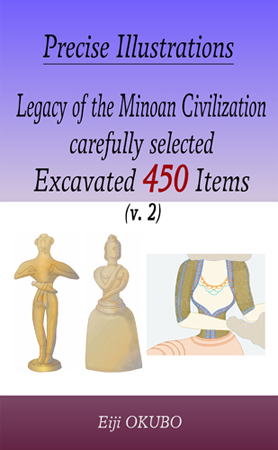 |
| subtitle: Touring to Minoan civilization with precise illustrations of
excavated artefacts language: English format: e-book / Web-download to Amazon-kindle, PC, e-book-reader, tablet-device, mobile-phone size: 454pages (kindle screen) / capacity: 562Mb sales: Amazon Network / Amazon.com / Amazon.co.uk |
| Sumary: This e-book is a “Precise Illustrations & Data Book” of excavated main items from the prehistoric Minoan Civilization ruins in Crete, and some finds from mainland Greece and Santorini Island. This e-book is picking up carefully selected “Excavated 450 Items” unearthed in important large to small archaeological sites in Crete, including the Knossos Palace and surroundings ruins, where were the center of the Minoan Civilization. More than 90% of the excavated items in this e-book explained are depicted in Precise Illustrations, and the rest are shown in Photographs, and including Detailed data and Descriptions of each individual find, along with associated data on the sites where they were unearthed. This e-book will invite you to the “World of Crafts and Arts” of the Minoan Civilization through carefully selected important works from among the excavated items on display at the Heraklion Archaeological Museum and other museums in Crete, and the National Archaeological Museum of Athens. Contents: What is the Minoan Civilization? I Jewelry Goods I-1 Gold Signet Ring I-2 Necklace & Pendant I-3 Gold Cup I-4 Gold & Silver Jewelry and Stones II Fresco II-1 Limestone, Stucco/Plaster, Fresco techniques II-2 Minoan Fresco II-3 Fresco Geometric Pattern II-4 Fresco Expressing Persons II-5 Fresco Expressing Animals II-6 Fresco Floral Expressing III Pottery III-1 Early Minoan Pottery III-2 Middle Minoan Pottery, Kamares style III-3 Middle Minoan Pottery, General Purpose III-4 Late Minoan Pottery, Palace style III-5 Late Minoan Pottery, Marine Design style III-6 Late Minoan Pottery, Floral Design style III-7 Late Minoan Pottery, Abstract & Geometric III-8 Late Minoan Pottery, General Purpose III-9 Ritual Rhyton III-10 Pottery Rhyton for Decoration III-11 Pottery for Daily Life IV Seal and Clay Imprint IV-1 Stone Seal IV-2 Ivory & Bone Seals IV-3 Clay Imprint V Stone Working V-1 Rhyton for Decoration V-2 Ritual Rhyton V-3 Stone Figurine V-4 Stone Building Structure V-5 Lamp & Daily Goods VI Minoan & Mycenaean Linear & Hieroglyph VI-1 Linear A VI-2 Linear B VI-3 Hieroglyph & Special Sign VII Bronze Work VII-1 Bronze Adorned Sword & Weapon VII-2 Bronze Double Axe VII-3 Bronze Adorned Vessel VII-4 Bronze Figurine & Daily Life VIII Terracotta Figurine & Larnax Coffin VIII-1 Votive offerings, Terracotta Figurine VIII-2 Terracotta Larnax Coffin IX Ivory Work IX-1 Ivory Works IX-2 Animal Bone & Fang Works X Agriculture & Fishing & Everyday Life X-1 Agriculture & Breeding & Costal Fishing X-2 Everyday Life |
| Sample Page:(excerpt) ---------- IV-3-01 Fresco, “Spiral line” & “Rosette” patterns  Site: Shrine, North Wing, Knossos Palace Shape & Decoration: Ceiling Relief Fresco, chained spiral, relief rosette, flower patterns Era: MMIIIA-LMIB, 1625-1450 BC Re. information: Papers, Sir Arthur John Evans “The PALACE of MINOS at KNOSSOS v. III” (1930) Local: Central North, Crete Drawing: Eiji OKUBO IV-4-02 Fresco, “Princess and Minoan youth” 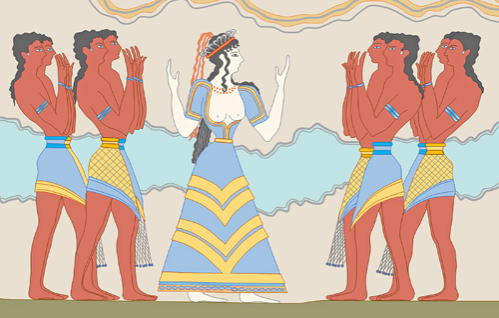 Site: Corridor of Procession Fresco, Southwest Wing, Knossos Palace Shape & Decoration: Fresco “Princess and Minoan youth” of “Procession Fresco” The princess wears an ivory tiara and a thick, luxuriously sewn skirt with the characteristic “V”-shaped pattern of the Minoan civilization. Era: MMIIIA-LMIB, 1625-1450 BC Museum: HAM Local: Central North, Crete Drawing: Eiji OKUBO From the moment tourists stand in the stone-paved West Court of the palace, they are immediately overwhelmed by the large-scale wall remains of the west wing and front façade/face of the palace that spread out before them, and then they head to the Corridor of Procession Fresco, where the entire wall connecting the West Porch to the Southwest Wing was decorated with impressive frescoes. The magnificent Procession Fresco painted on the wall of the corridor in the Minoan Era was the fresco equivalent to the astonishingly long story, far exceeding the emotions and feelings felt by those who stood there. The images are all very realistic, depicting male musicians in brightly colored saffron-dyed clothing playing seven-stringed lyres, two-pipe flutes, and sistrum; Minoan women dancing and singing with graceful movements of their hands to the rhythm of cymbals; a princess (goddess?) in an ivory tiara and splendid attire walking as if dancing, protected by a large number of young Minoan men in front and behind; and men carrying high-quality offerings, such as silver jugs and ceramic rhytons.  Site: Plan of West Court – West and Southwest Wing, Knossos Palace a) West Court & “Koulouras Pits,” West Pouch, Corridor of Procession Fresco=ground level b) South Terrace, South Gate, Central Court=ground level c) West Wing and Southwest Wing=2nd floor level Era: MMIIIA-LMIIIA1, 1625-1375 BC Re. information: Papers, Sir Arthur John Evans “The PALACE of MINOS at KNOSSOS v. II” (1928) Local: Central North, Crete Drawing: Eiji OKUBO IV-4-09 Fresco, “Goddess Parisienne”  Site: West Storeroom 12, West Wing, Knossos Palace Shape & Decoration: Fresco, “La Parisienne” so-called “Goddess Parisienne” Era: LMI, ca. 1500 BC Museum: HAM, inv. No. 11 / H250mm Local: Central North, Crete Photo: 1994 One of the fresco fragments found near Room 12 of the West Storerooms, which were used under the palace administration, on the first floor of the West Wing of the Knossos Palace ruins, was named "Goddess Parisienne" by the excavator Sir Arthur John Evans. When the Knossos Palace finally collapsed around 1375 BC, the wall of the sacred Northwest Sanctuary Hall on the upper (second) floor, where the fresco was painted, was destroyed by fire, and fell into the West Storerooms below along with a large amount of rubble from the building materials. Related: Mycenaean Gold Signet Ring, “Goddess” motif  Site: Royal Tholos Tomb, Tiryns Palace Shape & Decoration: Gold Signet Ring, “Treasure of Tiryns” Epiphany: a goddess sitting on a simple stool with a dove, raising a libation cup, four lion-headed daemons offering sacred vessels, the Sun and Moon in the sky, triglyph pattern Era: LHII, 1500-1400 BC Museum: NAM, inv. No. 6208 / L57mm, weight 83g, inner diameter of arm (loop) D23-24mm Local: Argolis, Peloponnese / 15km south-southeast of Mycenae Palace Photo: 1987 GPS: 37°35'47''N 22°48'45''E / ALT 20m A pair of a large gold signet ring measuring 57mm wide and a gold ring measuring 35mm wide were excavated from the burial pit inside of the Royal Tholos Tomb in Tiryns Palace in the Peloponnese-Argolis region of mainland Greece. These two gold rings are called the "Treasure of Tiryns" due to their beautiful sculptural expression. It is believed that two gold rings were presented to the king and queen, or prince and princess, of Tiryns Palace by the Minoan king of Knossos Palace on Crete in the LHII period of the Mycenaean civilization, around the 15th century BC. The large gold signet ring from Tiryns features extremely intricate and fine engravings. To the left of the seal, the goddess is seated on an X-legged stool in a sacred sitting position, holding a ritual cup in front of her with her right hand as if to receive the holy wine poured by four demons. On the left side of the seal, behind the goddess, there is a dove facing backwards, her messenger. In the Minoan civilization, the woman sitting on the X-legged stool was a goddess with the same appearance as a human, as seen in the fresco Goddess Parisienne at the Knossos Palace ruins. IV-4-14 Limestone Sarcophagus Fresco, “Funeral scene” 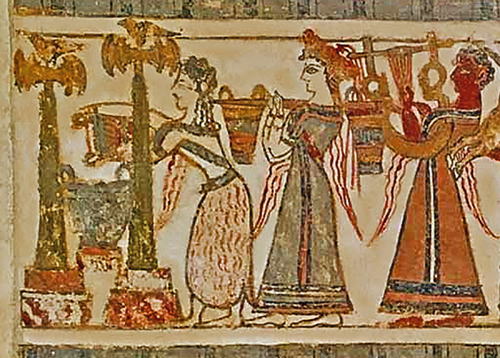 Site: Circular Tomb B, Agia Triada Shape & Decoration: Limestone Sarcophagus Fresco, “Funeral Scene” for male royal member Enlarge drawing=two large double axes with doves, sheepskin skirt female funeral staff pouring sacrificial bull blood by tilting vase, royal woman in a luxurious outfit with a tiara and hair ornament carrying two vessels with blood, long skirt musician playing 7-string lyre Era: LMIIIA2, 1375-1300 BC Museum: HAM, inv. No. 396 / L1,375mm Local: Messara Plain, Crete Photo: 1996 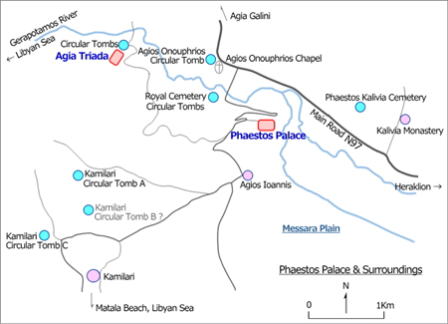 Sites of Phaestos Palace & Surroundings a) Phaestos Palace b) Royal Tombs of Phaestos Palace c) Common cemetery, Phaestos Kalivia d) Circular Tomb, Agios Onouphrios e) Quasi-palace & Circular Tombs, Agia Triada f) Circular Tombs, Kamilari Local: Messara Plain, Crete Drawing: Eiji OKUBO IV-4-16 Relief Fresco, “Minoan Princess” 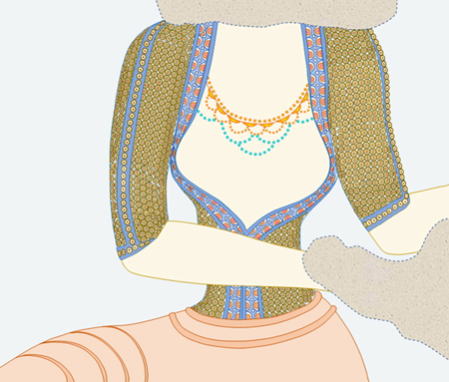 Site: Shrine, Pseira Shape & Decoration: Relief Fresco, “Minoan Princess” Era: LMIB, 1500-1450 BC Museum: HAM Local: Eastern North Coast, Crete / 13km east from Agios Nikolaos city Drawing: Eiji OKUBO GPS: 35°11'08''N 25°51'51''E / ALT 15m One fresco depicting the beautiful woman from the Minoan civilization, exuding grace and beauty, is the fresco "Minoan Princess or Goddess," found at the remains of the Shrine, the settlement on the island of Pseira on the north coast of Crete. This captivatingly elegant relief fresco depicts two women wearing unique costumes with intricate Minoan patterns was created during the heyday of the Minoan "New Palace Era with dancing Flowers," between 1500 and 1450 BC. Related: Mycenaean Ivory Statue, “Female or Goddess” 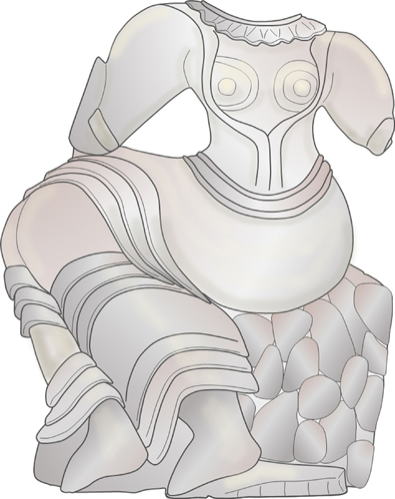 Site: Citadel, Mycenae Palace Shape & Decoration: Ivory Statue of Female or Goddess, sitting quietly on rocks Era: LHII-LHIIIA, 1500-1300 BC Museum: NAM, inv. No. 5897 / H85mm Local: Argolis, Peloponnese Drawing: Eiji OKUBO V-1-02 Carnelian Seal, “Lion attacking Bull” motif 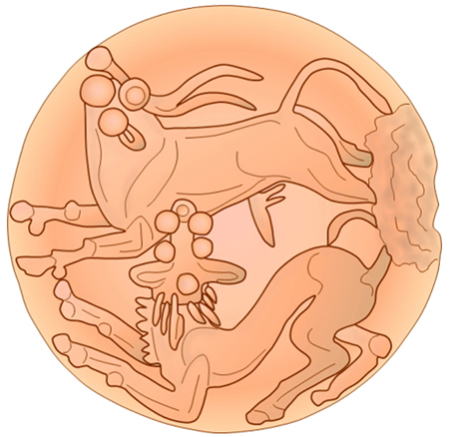 Site: Chamber Tomb 99, Common Cemetery, Zafer Papoura Shape & Decoration: circular lens-shaped Carnelian Seal, lion attacking bull Era: LMII, 1450-1400 BC Museum: HAM, inv. No. 687 / W18mm Local: Central North, Crete / 1km north from Knossos Palace Drawing: Eiji OKUBO GPS: 35°18'24''N 25°09'47''E / ALT 90m An excavation mission led by Sir Arthur John Evans identified over 100 tombs belonging to the Late Minoan civilization at the Common Cemetery at the Zafer Papoura site. The burial room of Chamber Tomb 99 is a square measuring 270cm on each side, and contains the remains of two adults with their heads facing west, and what appears to be a child, and it has been determined that the burials belonged to a family of three. A total of 19 items, probably for necklace beads, were found in the neck and chest area of the body believed to be a man, including a carnelian seal with a lion attacking a bull, an Egyptian scarab seal, and beads made of gold, ivory, crystal, steatite, and bronze. Related: African lion on the savanna grassland 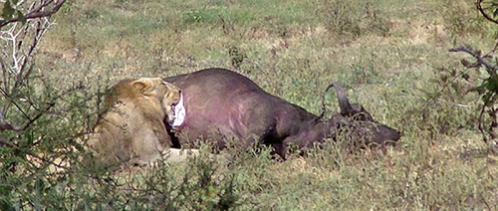 Female African lion preying on buffalo after attacking Local: Sabi River Basin, Kruger National Park, South Africa Photo: 2017 V-1-06 Carnelian Seal, “Cowherd & his Bull” motif 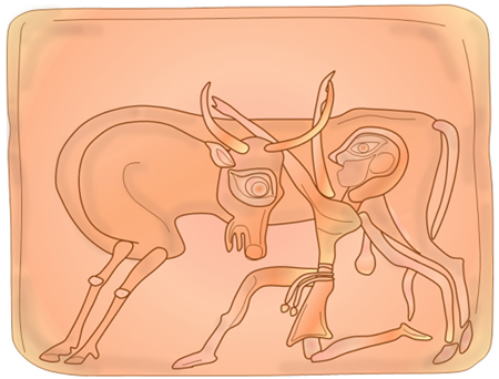 Site: Chamber Tomb 7, Phaestos Kalivia Cemetery Shape & Decoration: cushion-shaped Carnelian Seal, cowherd and his bull Era: LMIIIA, 1400-1300 BC Museum: HAM, inv. No. 169 / L18mm Local: Messara Plain, Crete / 1.3km east-northeast from Phaestos Palace Drawing: Eiji OKUBO Located 1.3km east-northeast of the Phaestos Palace ruins on the Messara Plain, the Phaestos Kalivia Common Cemetery was excavated in the 1920s by Greek archaeologist S.N. Marinatos. More than 10 chamber toms from the Late Minoan civilization have yielded grave jewelry belonging to high-ranking individuals who are clearly the aristocracy of the Phaestos Palace. A carnelian seal was excavated from Chamber Tomb 7, which is believed to date back to the LMIIIA period of the Late Minoan civilization, 1400-1300 BC. The seal, made of hard material and measuring 18mm wide and 14mm long, is a flat cylindrical (cushion-shaped) seal and features an image of a muscular, bearded man, likely a cowherd, with his left knee on the ground and his hand on the horn of a bull he is keeping, communicating with it. V-3-01 Clay Seal Imprint, “Goat & Papyrus” motif  Site: Central Great Staircase, West Wing, Knossos Palace Shape & Decoration: Clay Imprint, six goats or mouflons sitting quietly stamped with hard stone seal? Era: LMIIIA1, ca. 1375 BC Museum: HAM, inv. No. 231 / L24mm Local: Central North, Crete Drawing: Eiji OKUBO 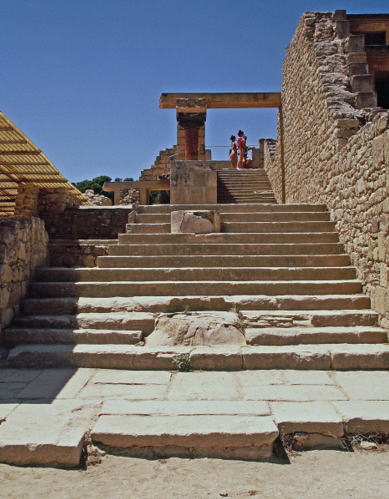 Site: Central Great Staircase, West Wing, Knossos Palace Situation: Largest Staircase in Knossos Palace connecting 2nd and 3rd floors from Central Court Era: MMIIIA-LMIIIA1, 1625-1375 BC Local: Central North, Crete Photo: 1994 VI-2-01 Serpentine “Bull-head shaped Rhyton” 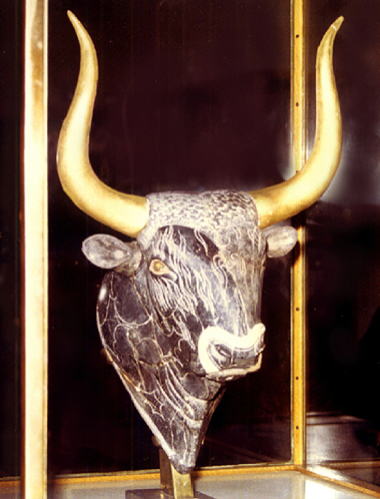 Site: Small Palace, Knossos Palace Shape & Decoration: Serpentine “Bull-head shaped Rhyton” Era: LMIB, 1500-1450 BC Museum: HAM, inv. No. 1368 / bull head excluding horns H206mm Local: Central North, Crete Photo: 1982 The serpentine or steatite "Bull-head shaped Rhyton" was found in the Knossos Palace Area, 350m northwest of the Central Court, in a large and magnificent building ruins that researchers call the "Small Palace." In the Minoan civilization, the bull was a sacred symbol of power worshipped by the people, and various rhytons in the shape of bull's heads were used in religious ceremonies and rituals. In addition to stone bull-head shaped rhytons, many terracotta rhytons (v. 1-II-9-18/-19) have also been excavated from Minoan civilization ruins. It can be understood by looking at the surface gloss of the actual Bull-head Rhyton excavated from the Knossos Small Palace, which is on display at the Heraklion Archaeological Museum HAM, that the left half (right on photo) of the head from the center is the real part from the Minoan Era, and the slightly shiny right half (left on photo) is the replica. The horns were, however, made of wood and corroded, so they were not found during the excavation. The bull's eyes are made of rock-crystal, the eyelashes are of jasper, the nose is inlaid with pearl oyster, and a small hole on the top is believed to have been used to pour the blood of the sacrificial bull during rituals. The rhyton is said to have been made during the heyday of the New Palace Era, during the Late Minoan LMIB period, 1500-1450 BC. The Bull-head shaped Rhyton, a cult statue of the "New Palace Era with Dancing Flowers," is one of the trademark treasures that are worthy of symbolizing the Minoan civilization. Related: Mycenaean Silver “Bull-head shaped Rhyton”  Site: Shaft Grave IV, GCA, Mycenae Palace Shape & Decoration: Silver Bull-headed shaped Rhyton horns, rosette pattern, mouth part in gold decoration Era: LHI, ca. 1550 BC Museum: NAM, inv. No. 384 rosette crest on the forehead width L56mm Local: Argolis, Peloponnese Drawing: Eiji OKUBO Ralated: Mycenaean Linear B Clay Tablet from Knossos Palace 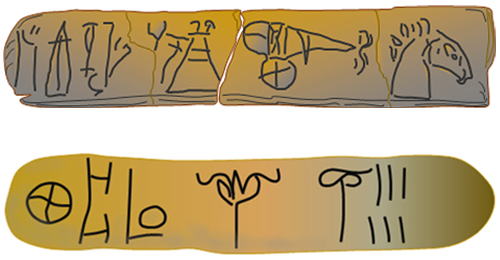 Site: Royal Sanctuary Area, West Wing, Knossos Palace Shape & Decoration: Mycenaean Linear B Clay Tablet, “Two-wheeled Chariot” Ideographic translation by Richard Vallane Janke (2016) = (Person’s name) in armor drives a two-wheeled chariot Era: LMIIIA1, ca. 1375 BC Museum: HAM, inv. No. 1609 / L100mm Local: Central North, Crete Drawing: Eiji OKUBO Site: Sanctuary Area, West Wing, Knossos Palace Shape & Decoration: Mycenaean Linear B Clay Tablet, “Saffron” a) Ideographic translation: "(three-letter personal name) - blooming saffron flower - quantity 6 units” b) Unit notation: 〇 100 units / a horizontal line 10 units / a vertical line 1 unit Era: LMIIIA1, ca. 1375 BC Museum: HAM Local: Central North, Crete Drawing: Eiji OKUBO X-2-01 Grape Press Device & Wine-brewing Vessel 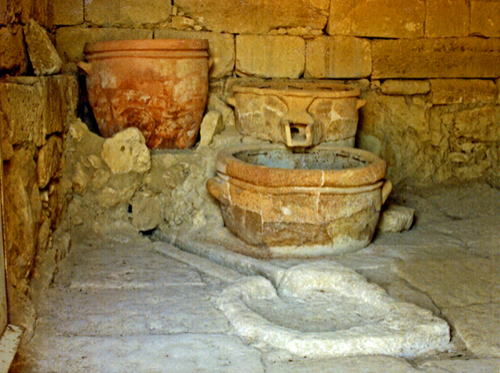 Site: Wine Brewing Room, House of Vathypetron Situation: Grape Press Device before wine-brewing a) upper= two grape crusher large vessels b) lower= grape juice storage vessel & channel Era: LMIB, 1500-1450 BC Local: Central North, Crete / 3km south-southwest from Archanes Photo: 1982 GPS: 35°12'35''N 25°09'03''E / ALT 510m The House of Vathypetron is located at an altitude of 500m, about 3km south-southwest of Archanes town on the side of the local road (Patsides=Vathypetron). The mansion was built around 1500 BC in the middle of the prosperous New Palace Era, and 50 years later, around 1450 BC, it was destroyed by the attack from the Mycenaeans who invaded from mainland Greece, and was subsequently abandoned. In the southeast section of the mansion, in the Plaster-floor Room, two sets of grape press device for wine-brewing were discovered, consisting of three large vessels arranged at different levels and the grooved reservoir cut just above the floor. This is the so-called Foot-operated Press used to crush the grapes, the first important step in winemaking. ---------- |